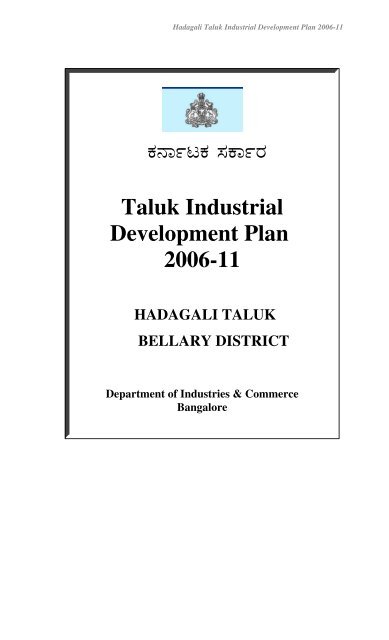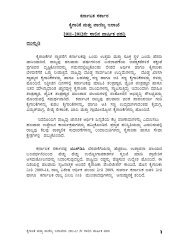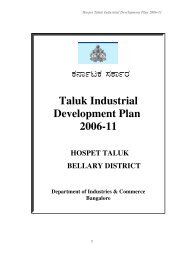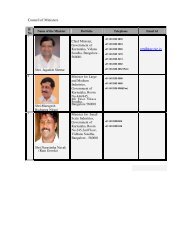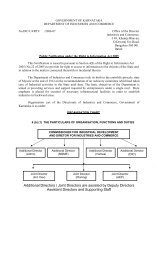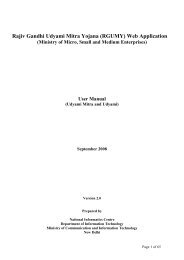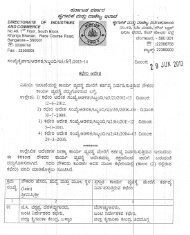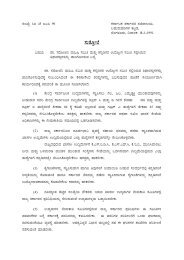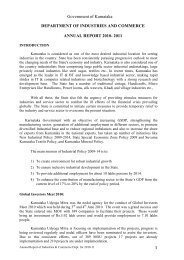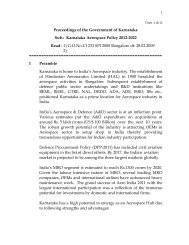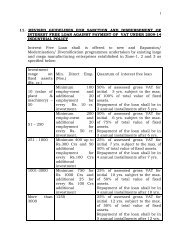Word Pro - DIDP Hadagali - Karnataka industry
Word Pro - DIDP Hadagali - Karnataka industry
Word Pro - DIDP Hadagali - Karnataka industry
- No tags were found...
Create successful ePaper yourself
Turn your PDF publications into a flip-book with our unique Google optimized e-Paper software.
<strong>Hadagali</strong> Taluk Industrial Development Plan 2006-11N®w¯ÁhN® š®N¯ÁŠ®Taluk IndustrialDevelopment Plan2006-11HADAGALI TALUKBELLARY DISTRICTDepartment of Industries & CommerceBangalore
<strong>Hadagali</strong> Taluk Industrial Development Plan 2006-11District Industrial Development Plan - 2006-07 to 2010-11<strong>Hadagali</strong> TalukaTable of ContentsSl. No.Chapter particularsPage No.From To1Introduction122Identified Investment Opportunities383Taluka at a Glance9134Resource base of the taluka14165Infrastructure Facilities and New Developments17246Existing Industrial Base25267Salient Features of Important Central and StateGovernment Schemes for Development of Industries27318List of Important addresses and phone nos3232Annexure-II3338
<strong>Hadagali</strong> Taluk Industrial Development Plan 2006-11Chapter 1Introduction<strong>Karnataka</strong> is one of the top five industrialised states in the country. It has a history ofpioneering industrial development initiatives. The state GDP growth rate during 2005-06 was8.7 percent, with the industrial sector accounting for 18 percent. The new industrial policy2006-2011 announced by the Government of <strong>Karnataka</strong> in the end of August 2006 envisages agrowth rate of over nine percent in gross state domestic product. This is sought to beachieved with an industrial sector growth of over 12 percent.1.2 With this end in view, the Commissioner of Industries and Commerce, Government of<strong>Karnataka</strong> had commissioned the preparation of a District Industries Development Plan(<strong>DIDP</strong>) for all the 27 districts in the State of <strong>Karnataka</strong>. The <strong>DIDP</strong> is to capture the resourceendowments of the district, both natural and human and outline the potential fordevelopment of industries in the district, taking into account the Infrastructure alreadyavailable, the existing industrial base of the district, etc. The <strong>DIDP</strong> was to a have a five yearperspective- 2006- 11. Since the Plan is a forward looking one, the action required to beinitiated to realise the potentials identified were also to be identified. The <strong>DIDP</strong> was to beprepared Taluka wise and was also to contain useful information for the users, including thevarious schemes being implemented in the district/ taluka, important contact addresses, etc.The <strong>DIDP</strong>, in short, was to provide useful and relevant information for all readers, who mayrefer to the document, with the purpose of scouting for information for setting up industrialunits/ ventures in the Taluka.1.3 The task of preparing such <strong>DIDP</strong>s were entrusted to various agencies, and NABCONS (awholly owned subsidiary of the NABARD) had been entrusted with the task of preparing theplans in respect of three districts, viz., Bellary, Chamarajanagar and Shimoga.Methodology1.4 A three Step process was adopted for compiling the report. The first Step involved thecollection of the resource endowments of the district (taluka wise, as the report was to bepresented talukawise)- both natural resources and human resource, the availableinfrastructure- communication, power, water supply, existing industries, etc., and otherdetails regarding facilities available in the districts/ talukas, etc. The information collectedthus is presented in the Report.1.5 Since the potential for industrial investment depends on the availability of raw material,demand for goods and services, availability of supporting infrastructure, skilled manpower,entrepreneurial ability, etc., the data collected in the first Step were analysed to narrowdown on sectors which were predominant in the district/ talukas and detailed discussionswere held directly with officials of the concerned government departments/ agencies tosecure additional information on the extent to which developments have taken place in those1
<strong>Hadagali</strong> Taluk Industrial Development Plan 2006-11sectors, the trends, etc. Based on these detailed discussions, a SWOT analysis of individualtalukas were prepared. The potential for setting up of industries in specific sectors were alsoidentified. At this stage, the Reports were ready in a tentative/ provisional form. Therecommendations were to be scrutinised and vetted by the stake holders.1.6 Therefore, as the third Step, a Workshop of the stakeholders was arranged, with theparticipation of Government officials from various departments, mainly the DIC, agriculture,horticulture, industries’ associations, NGOs, etc. This Workshop was convened with the helpof the CEO, ZP. The outcome of the study thus far were presented at these Workshops anddiscussions were held in a participatory manner. Based on the feedback received in theseWorkshops, the report is finalised and presented here.This report covers <strong>Hadagali</strong> taluka of Bellary district.2
<strong>Hadagali</strong> Taluk Industrial Development Plan 2006-11Chapter 2:Identified investment opportunities2.1 Based on the detailed discussion we had with bankers, Govt. Departments, Industryassociations, and NGOs to ascertain the potential as well as the problems, a list of industrialactivities having potential in the talukas were identified and details of feasible numbers,investment required and scope for employment were quantified. While doing so, the activitieshave been classified under 3 major heads as under :High Share Sub-sectors : Those which at present account for a high share of industrialactivity in terms of employment.High Growth Sub-sectors : Those which have registered a high growth rate ofemployment due to demand in the domestic and / or export market.Emergent Sub-sectors : Those which at present support relatively little employment butwhich, in the opinion of informed persons, have a potential for growth in the nearfuture because of unsaturated demand.Potentials Identified in terms of Employment Opportunities for <strong>Hadagali</strong> talukSlNo1High Share Sub-sectorSupplementary industrialunits JVSL & KPC , Garmentsand related industriesHigh Growth Sub-sectorBuilding material, mining,transport, retreading,vulcanising, service station,automobiles & spare parts,vehicle body building, greasemaking, milk products, footware making, grill works, cardboard making, preparation offood and spice items, houseconstructions, plumbers, blacksmith, gold smith, plasticmoulding unitsEmergentSub-sectorService sectorunits, preparationof toys and bags,Candles,Agarbatti, Phenyl,detergents,aerated andmineral waters,shamiana andutensils supply,luggage autos2.2 SWOT AnalysisSince the potential for industrial activities referred to in para 2.1 above were assessed onthe basis of discussion with individual Departments/Agencies, it was decided that these are tobe vetted through a consultative process by conducting a participatory workshop in thedistrict. The workshop was conducted with the participation of various Senior District/Talukslevel officials representing various Departments viz. Industries, Agriculture, Horticulture,Electricity/Power, Animal Husbandry, Fisheries, Financial Institutions/Banks, representativesof Industries Associations/individual entrepreneurs, etc. The workshop was conducted inconsultation and association with the Chief Executive Officer, Zilla Panchayat.The participants working in groups, had considered the resource endowments of each Taluka,their (Taluka’s) strengths and weaknesses and the opportunities provided and threats posedby the external environment. The groups had examined/discussed the industrial potentialsidentified and had moderated/vetted/made suggestions thereof. For each taluk, strengthsand opportunities were taken into consideration based on the information on resource3
<strong>Hadagali</strong> Taluk Industrial Development Plan 2006-11endowments of each of the taluka provided to the groups. The weaknesses of the taluka andthe threats were summerised as action points which need to be addressed. The final potentialfor activities in the Taluka are given below. The year-wise projections of industrial potentialfor the year 2006-07 to 2010-11 are given in the Annexure (at the end of the Report).Summary of Activity-wise industrial units, estimated financial outlay and employmentpotential in <strong>Hadagali</strong> taluk for the period from 2006-07 to 2010-11Sr.No.ISector / Sub-sector / ActivityAgro-based and food productsUnitsFin.Outlay(Rs lakh)Emp.GeneratedPoha MillTomato products (ketchup, sauce)51460.658.764528Tamarind PasteAerated water and soft drinks15627.88126048Bread and Bakery productsConfectioneryFlour mill & Chilly poundingSweets & SavoriesDairy Milk <strong>Pro</strong>ductsIce candy & Ice CreamMasala powder and condiments121015161241545.917.8125.7511.0531.1613.1327.972506048602490PapadBee keepingPicklesPuffed RiceRoasted & Salted Ground nuts1571941522.1915.7142.6710.912.89300353803230VermicilliPotato ChipsSub total151421313.322.81422.4660561478IIAgro processing industriesDaal MillsSaw MillsMilk Chilling unitsNeem Oil ExtractionDecorticating unitsSub total44442036101.668.798.562.54127.4398.8040448020100284IIIHANDLOOM / READYMADE GARMENTSSECTORWoolen/ Kambli WeavingHosieryHandloom Weavers FinanceJeans garmentsCotton ginning & pressingSub total5000054.3800004.3825000025IVChemical, leather & plastic productsAgarbattiCamphor tabletsPhenylCleaning powderDistilled water for automobiles2591111316.713.0912.19.712.11550108888894
<strong>Hadagali</strong> Taluk Industrial Development Plan 2006-11Sr.No.Sector / Sub-sector / ActivityInjection moulded plastic articlesUnits5Fin.Outlay(Rs lakh)13.77Emp.Generated75Candle makingLeather articles/ footwearsPaints & primers mfg.Reprocessing of plasticsPVC FittingsPlastic GranulesTyre retreadingSub total9535212918.1544.248.3331.0414.7516.525.5255.95726027501610201173VElectrical/Electronics & Computer BasedInds.Battery charging/ servicingBattery Eliminators/ Power packs559.1812.473525Invertors upto 50 kvaVoltage StabilizersEmergency lampsDTP CentresElec.Repairs/ motor rewinding5578810.8810.889.215.2712.51530213240Sub total4380.38198VIMineral based and building materialproductsHollow concrete blocksJelly crushingSoil Cement BlocksTable moulded bricksMosaic tilesSub total15565229.7587.44.4566.95116.57285.1215753012050290VIILivestock based productsCattle / Poultry feedDressed Broiler chiken unitSub total12719145.8510.57156.4214421165VIIIMechanical based productsDiesel Engine servicingGalvanising UnitSteel/re-rolling millsSteel fabrication & furnitureAlloys Steel manufactureFoundry unitsBarbed wireAgricultural implementsGeneral EngineeringSub total7401300755416.67267.270199.310045.4946.1515.37580.2628140015600282525402IXTourism related projectsMotelsFast food centresMini busesSub total7872212.0973.8140.82126.723514428207XInfrastructure projects5
<strong>Hadagali</strong> Taluk Industrial Development Plan 2006-11Sr.No.Sector / Sub-sector / ActivityUnitsFin.Outlay(Rs lakh)Emp.GeneratedCommercial complexes118.59Sub total118.509XIRural ArtisansStone carving103.720Carpentry1625.5180Goldsmithy98.7118Pottery/ Terracota articles108.950Other artisans (tailoring, laundry, barbers etc.)2213.94110Balcksmithy65.4930Mirror embroidery5930.82295Soft toys190103.4950Sub total322200.471553XIISRTOAuto Rikshaw2021.420Mini trucks9139.2727Goods carrier/ trucks12186.536Passenger Bus12151.46108Sub total53498.63191XIIIPROFESSIONALS & SELF EMPLOYED791.44140Sub total791.44140XIVOthers IndustriesCorrugated Boxes3116.0224Ice Blocks & Ice Industry426.0420Vermicompost14145.470Coir products (rope, mats, etc.)414.828Wooden furniture, doors and windows814.132Book Binding & Note Books519.7225Paper envelopes519.5625Mineral water11015School bags46.344Bee keeping98.1518Cane & Bamboo53.4150Sub total62383.5351XVOther Service SectorsVulcanising/ air compressor units52.7110Weigh Bridge564.5610Pollution Control Certification Centres65.36Service station for automobiles559.8125Auto servicing57.6150Cyber Caffes420.758Beauty parlors1010.6230Fax STD Centres58.0210Pathological Centres1010.9260Nursing Homes6109.3254Genset Repair & Hire412.6412Tractor servicing/ repair1526.6460Computer Trg. Inst.565.1615Digital photo studio4127.6620Screen printing61.45126
<strong>Hadagali</strong> Taluk Industrial Development Plan 2006-11Sr.No.Sector / Sub-sector / ActivityOffset printing unitPhoto copyingServicing & repairing of consumer ele.pro.Units465Fin.Outlay(Rs lakh)61.999.35.52Emp.Generated361220Repairing & Servicing of Pumps2115.2684Oil GanaSub total51369.21634.4510544XVISHG Micro EnterprisesSub total20120169.269.210051005Grand Total12744206.6880157
<strong>Hadagali</strong> Taluk Industrial Development Plan 2006-11Chapter 3Taluk at a Glance3.1 <strong>Hadagali</strong> taluk takes its name from its headquarters town. There are several stories incirculation regarding the origin of its name.The full name of the village is Huvina<strong>Hadagali</strong>.Huvu means flower; Hadaga means boat and Halli means village.Therefore it is a“village of flower boat”. It is believed that when the city of Vijayanagara flourished flowersneeded for temples and palace were floated down from Tungabadhra from this place. As if toconfirm this even today it can be seen number of old wells and gardens in this place. Thegeographical area of the taluk is 948 sq.km. and population is 168118 as per 2001 census. Thisaccounts for 8.29 p.c. of district’s population and its area accounts for 11 p.c. This talukoccupies sixth place both in area and population.Sr.No.1(i)(ii)(iii)(iv)(v)(vi)(vii)(viii)2(i)(ii)(iii)(iv)(v)ItemPopulationTotalRuralUrbanMaleFemaleSC populationST populationDensity in populationLiteracyTotalMaleFemaleUrbanRuralUnitsLakh""""""persons persq.kmthousands""""Data1.681.450.230.850.830.380.1317786523414723.2 Administrative set up<strong>Hadagali</strong> comes under the administrative jurisdiction of Hospet revenue sub-division with 3 R Icircles. However <strong>Hadagali</strong> is one of the two Z P Engineering sub-divisional headquarters in thedistrict. The taluk is divided into three Hoblis. It has 56 villages, 24 Gram Panchayats and 1town panchayat.3.3 PhysiographyThe taluk is bounded on the south by the Harpanahalli tauk of Davanagere district, on thenorth by Mundargi and Sirahatti of Gadag district, on the east by the Hagaribommanahallitaluk and on the west by Haveri and Ranebennur taluks of Haveri district. The Bellary districtis situated between 14 degrees 30’ and 15 degrees 50’ north latitude and 77 degrees 40’ Eastlongitude. The district is situated in a semi-arid zone. The geographical location is at 1512 ft.Height from the main sea level. The western parts of the taluk is hilly with iron deposits.3.4 Soil Conditions & Topographical FeaturesThe Bellary district consists of archern complex composed of crystalline schist’ epidorities,granites and later granites. The soil content of the taluk is black cotton with red loamy. Thesoil in the western parts of Bellary is red loamy with hilly area having rich minerals like ironore of 65% ferrous and manganese ore of 40-48% manganese. The main river Tungabhadra8
<strong>Hadagali</strong> Taluk Industrial Development Plan 2006-11enters the district in the village Kuravatti of <strong>Hadagali</strong> taluk. The river Chikka Hagari flowsthrough Kudligi and Hadagalli taluks and joins back waters of Tungabhadra reservoir.3.5 Seasonal & Climatic ConditionsThe Bellary district falls under semi-arid zone with dry climate. The temperature range frommin. 13 degrees Celsius during December to a maximum of 44 degrees Celsius in April andMay. The taluk is known for its hot summer and a dry weather persists for a major part of theyear. Average rainfall for the taluk is about 615.5 mm per annum, which precipitates in about32 rainy days. Usually August and September months get maximum rainfall.3.6 Land use Pattern:The current pattern of land utilization is as follows:Land UseForestsBarrenNon agricultureCultivable wastePermanent pastureCurrent fallowOther followsNet area sownTotal geographical areaArea sown more than onceArea (ha)47382766939717472216225221455132294853217023.7 IrrigationThe net irrigated area constitute only 10366 hec. hec.(15 p.c.). The main source of irrigationis as under:Sl.no.ParticularsArea (hec.)Percent1 Lift Irrigation2 Tanks3 Wells/BorewellsTotal area under irrigation5052193933751036648.7318.7132.56100.003.8 Predominent Economic Activities prevalent in the taluk3.8.1 Agricultural sectorAgriculture contributes major portion of the income of the taluk. The major crops grown aremaize, jowar, bajra, sunflower, groundnut and cotton. Though the productivity has shown adeclining trend in the last few years, performance is better than the state average in terms ofproduction and yield with reference to paddy, pulses, jowar and cotton. Major horticulturalcrops grown in the district are chillies, coriander, pomegranate, mango, fig, and coconut.3.8.2. Industrial Sector<strong>Hadagali</strong> is one of the most backward taluks in respect of industrialization in the district. Inthis taluk there are 607 industrial units with an investment of Rs. 396.33 lakh. These units9
<strong>Hadagali</strong> Taluk Industrial Development Plan 2006-11provide employment to 2051 persons. There are 1089 Rural artisans whose activity comprisesof Carpentry, Blacksmith, Barbers, Tailoring, Rope making, Pottery, Lather, Cotton weavingand Mat weaving.3.9 Performance of Credit AgenciesThere are 18 bank branches in the taluk. The details of outstanding deposits and advances asat the end of March 2006 are furnished below.(Rs. lakh)Sr. #1235AGENCYCBsPGBBDCCBPCARDBsTotalNo .ofbranches494118AdvancesOutstanding % of share3,205.97 39.63,158.53 39.11,494.03 18.5228.7 2.88,087.23 100DepositsOutstanding % of share2,780.19 41.82,217.37 33.31,578.09 23.777.971.26,653.62 1003.10 Credit-Deposit (CD) RatioThe CD ratio of CBs, PGB and BDCCB was at 115, 142 and 95 respectively as at the end ofMarch 2006. The overall CD ratio of the formal banking system in the taluk was at 122% as onthat date.3.11 Ground level credit flowDuring 2004-05, Banks have disbursed Rs.74.58 lakh as against target of Rs. 83.60 lakh in<strong>Hadagali</strong> taluk under non-farm sector which includes activities like Handloom/powerloom,village and cottage industries, tiny industries, SSI and Rural Artisans. Similarly under OtherPriority Sector which includes activities like Road transport operators, professional and selfemployed, rural housing, small business and retail trade, consumption loans, banks havedisbursed Rs.865.53 lakh as against the target of Rs. 706.90 lakh during 2004-05 in <strong>Hadagali</strong>taluk.3.12 Places of Interest:(a) Hire-<strong>Hadagali</strong>:temples.This village which is 17 kms away from <strong>Hadagali</strong> has famous Chalukyan(b) Kogali:Kogali village was once a Jaina centre. One can find Jaina temple here with animage of Teerthankarain in the posture of contemplation.(c) Kuruvatti: This village is situated on the bank of Tungabadhra at a distance of 36 kmsfrom <strong>Hadagali</strong>. Every year during car festival cattle fair is conducted with much fanfare.(d) Magala: Magala village which is 25 kms from <strong>Hadagali</strong> is noted for Chalukyan templededicated to Venugopalaswamy.(e) Mylara: This village is situated at a distance of 33 kms. from <strong>Hadagali</strong> and 2 kms. fromTungabadhra river. The temple here is dedicated to Lord Shiva in the form of Mailara.Mailarameans defeater of Malla. Mylara Jathra is very popular in and around <strong>Hadagali</strong> taluk. Thisannual festival attract a large number of devotees from all over the state.10
<strong>Hadagali</strong> Taluk Industrial Development Plan 2006-11Chapter 4Resource base of the taluka4.1 AgricultureAround 60% of the population depends on Agricultural activity, rice is the staple food. Intotal 57% of the land is utilised for the agricultural activity. The main crops in <strong>Hadagali</strong> Talukare as under :Sl.No.1234567Name of thecropPaddyJowerMaizePulsesGroundnutSunflowerCottonSown area during2005-06 (in ha.)4,67513,1129,8159,98212,04029,3845,3354.2 Horticulture<strong>Pro</strong>duction of Horticultural crops in <strong>Hadagali</strong> Taluk as on 31.03.2005 is as under :Sr.No.I1234II1234III12IV1534V12Name of the cropFruit CropsMangoBananaSapotaGuavaVegetable CropsTomato (Rabi & Khariff)CucumberBrinjalOnion Kharif & RabiSpicesTamarindDry ChilliOther Horti CropsLadies FingerCoconut (lakh nuts)Oil PalmBetelvine(lakh leaves)FlowersJasmine flowerMari GoldArea (Ha.)606550169957148561979313325523212868<strong>Pro</strong>duction(M.Ton)9002,2756004002,97096956017,120951,58613032.5122.28896680yield/ha.153512253017402052100.12.350.25710Value (Rs.lakhs)135.0045.5036.008.00112.2019.3822.40510.4021.50634.406.5097.504.890.6489.6034.004.3 Forest4738 ha. or 5% of the area is covered by forest. The following activities can be taken up inthe forest area : Bee keeping, Basket making, Manufacture of bags from natural fibres, ropeweaving, collection of minor forest produce, Agarbatti making, Organic farming, Furnitureshop, neem oil/cake manufacturing, Extraction of oil from aromatic plants etc., activities canbe implemented.11
<strong>Hadagali</strong> Taluk Industrial Development Plan 2006-114.4 Animal HusbandryAnimal Husbandry is the main allied activity next to Agriculture in <strong>Hadagali</strong> Taluk.(i)(ii)(iii)(iv)(v)(vi)Indigenous cattleCross BreedBuffalousIndigenous sheepGoatsPoultryno.no.no.no.nono36,1623,18415,97450,10425,56630,991Dairy and Sheep/goat rearing are the main activities in the taluk. Dairy developmentactivities in the district are carried out as supplementary activities. The per capitaavailability of milk in the district is 170 gm/day as against the normal requirement at aminimum of 240 gm per day as per Indian Council of Medical Research (ICMR). Raichur-BellaryMilk Union (RBMU) covers Raichur, Koppal and Bellary districts. It has created infrastructuresupport to suit its requirements. There is one milk processing unit at Ittagi village in thetaluk. The milk production in <strong>Hadagali</strong> taluk during 2005-06 was 16670 LPD. In <strong>Hadagali</strong>taluk, there are 6 broiler farms with annual meat production of 46 tonnes.4.5 FisheriesFisheries is one of the important sectors in the socio-economic set up of Bellary district. Itprovides animal protein to population, generates large-scale employment and earns valuableforeign exchange. Fish farming is a traditional activity as the district is endowed with freshwater resources consisting of tanks, reservoirs, rivers, canals and ponds. There is a goodscope for inland fisheries, particularly pond fisheries, tank and riverine fisheries. There are16 irrigation tanks in the taluk. The fishermen population in <strong>Hadagali</strong> taluk is 8200. In<strong>Hadagali</strong> taluk, total fish production during 2005-06 was estimated to be around 448.50tonnes. During the past five years , the construction of fish ponds in Bellary district wasencouraging. As on 31.3.2005, there are 5 fish ponds in the taluk.4.6 Human ResourceThe details of educational institutions in <strong>Hadagali</strong> taluk are indicated below.Educational InstitutionsPrimary SchoolsHigh SchoolsPre-universityDegree CollegesNumber ofinstitutions1662751No. of students30,8286,2111,243753Classification of workers:(i)(ii)(iii)(iv)(v)CultivatorsAgricultural labourersWorkers in household<strong>industry</strong>Other workersTotalthousands""""244431485As per 2001 census, 801369 constituting 40% of the total population are main workers ofwhich 30% are agriculturists, 34% agriculture labourers and the remaining 36% are other12
<strong>Hadagali</strong> Taluk Industrial Development Plan 2006-11workers. Of the total main workers, 34% are female workers. More than 68360 are registeredfor employment with the Employment Exchange in the district as at the end of March 2005,out of which 5469 are from <strong>Hadagali</strong> taluk. CEDOK, GTTC, SIRD, RUDSETI, Chitradurgaorganizes EDPs, Management Development <strong>Pro</strong>grammes and awareness creating/Skilldevelopment programmes with a view to motivate rural youth to establish their own SSI units.The following table shows that existing manpower which is not sufficient to meet thedemands of the existing and implementing medium and large scale industries.Sr.No.12345678910ParticularsDegree holdersDiploma holdersITIStenos & TypistsSSLCPUCDriving license holdersBelow SSLCOthersTotal registeredTotal399933781391,9297901661,1923835,46913
<strong>Hadagali</strong> Taluk Industrial Development Plan 2006-11Chapter 5Infrastructural facilities and new developmentsThe district fares fairly well under some of the infrastructure indicators such as Electricity,Irrigation, Transportation, Water supply, education, and agricultural markets where theranking of the district is better than the State average. Infrastructure facilities act ascatalysts in the development. In 1995, the GOI set up Rural Infrastructure Development Fund(RIDF) with NABARD for sanctioning loans to State Governments for development of ruralinfrastructure. 465 projects with an outlay of Rs.88.15 crore and RIDF loan of Rs.77.22 croresanctioned by NABARD for the district covering mainly rural roads and bridges, MinorIrrigation projects, recharging of ground water structures, , anganawadi centres, primary andsecondary schools, rural markets, godowns. District offers scope for infrastructure projects inminor irrigation sector to increase irrigation facilities, improvements to rural roads forall-weather connectivity, development of infrastructure facilities such as rural drinking watersupply, health service projects, creation of water recharge structures, rain water harvestingstructures etc.5.2 PowerThere are 2 power generating stations in the taluk i.e. one at sogi with 52.5 MW capacity andanother at Gujanoor with 17.5 MW capacity. It is proposed to set up Tungabhadra mini Hydalscheme near <strong>Hadagali</strong>. In the taluk, there are 4498 distribution lines per 1000 sq.km and 223electric connections per 1000 population. Per capita power consumption in industries is 4041kw per annum whereas per capita consumption for all users is 2360 kw.5.3 WaterThe position of drinking water facility in the taluk is given below:Rural Drinking Water1Flouride affected villagesNumber092BorewellsNumber3733Mini Water Supply schemesNumber944Piped Water Supply schemesNumber555.4 Road and Rail connectivityThere is no rail route passing through the taluk. The road connectivity of the taluk areindicated below:Sl.No.(i)(ii)(iii)(iv)(v)(vi)(vii)Type of RoadNational HighwayState HighwayMajor dist. roadsother dist. roadsvillage roadsirrigation dept., roadsTDB Roadskms.kms.kms.kms.kms.kms.kms.Length24.5124.31122.4516250.6515109.214
<strong>Hadagali</strong> Taluk Industrial Development Plan 2006-11Industrial Estates and AreasKSSIDC has developed one Industrial estate during 1983 in <strong>Hadagali</strong> taluk and the details areas under.IndustrialEstate<strong>Hadagali</strong>Landacquired(acres)5.28Total no ofsitesdeveloped34Sitesallotted12No of shedswhere sale deedexecuted0Vacant sheds22Under VISHWA Scheme, 2 sheds have been constructed in the taluk and the same areallotted. However, units are yet to start functioning in these sheds.5.5 Other factors affecting the economy of the District:The State Government has announced Bellary package of Rs 3300 crore for the overalldevelopment of the district and solve the problems such as poor roads, drinking water anddrainage problems, education, Health including veterinary health etc, to be implemented innext three to four years.5.6 New industrial policy 2006-11-<strong>Karnataka</strong>The Government of <strong>Karnataka</strong> has announced the new industrial policy-2006-11 vide its orderdated 26 August 2006. The policy envisions the following:The state to achieve a Gross State Domestic <strong>Pro</strong>duct (GSDP) growth of over 9%, which inturn will call for industrial sector growth rate of over 12%Strengthening the manufacturing <strong>industry</strong> in the state and increase its share of the GSDPfrom the present average of 16.7% to over 20% by the end of the policy periodAchieve an increased share of <strong>Karnataka</strong>'s exports in the National exports from thepresent 15% to 20%Create additional employment generation for at least a 10 lakhs persons in themanufacturing and service sectors<strong>Pro</strong>mote diversified industrial base which would strengthen both the old economy and neweconomy fieldsFacilitate reduction of regional imbalance in the matter of economic opportunities,employment and growth<strong>Pro</strong>mote sustained industrial growth by facilitating accelerated flow of investmentsThis vision is sought to be achieved by following the strategy indicated belowThe various talukas of the state have been categorised into three Zones for the purpose offocussed attention.Zone 1- consisting of 79 talukas- most/ more Backward Taluka as categorised by Dr.Nanjundappa committee report;Zone 2- consisting of 85 talukas (taluka not covered in Zone 1 and 3) and15
<strong>Hadagali</strong> Taluk Industrial Development Plan 2006-11Zone 3- consisting of 12 talukas of Bangalore urban and rural districts (excludingtalukas of Kanakapura and Magadi), Mangalore and Mysore talukas.To develop industrial infrastructure facilities ahead of the requirements, in various keylocations of the state through the KIADB / KSSIDC. The industrial areas developed wouldinclude areas for housing and other social infrastructure.Implementation of the industrial water supply schemes would be facilitated by thegovernment through Special purpose vehicles.Government would facilitate the preparation of "gas distribution master plan" to enablepublic/ private sector players to bring in gas from diverse sources for distributionSpecialised industrial infrastructure for specific sectors and the Special Economic Zoneswould be encouraged to be establishedIndustrial corridor/ cluster development would be increased in potential locations.Alternate partnership and financing options for infrastructure development would beencouragedA separate package would be formulated in consultation with the sericulture departmentfor the silk reeling sectorImpetus for development of renewable and non-conventional energy sources throughmission approachGovernment would help promote/ help facilitate the establishment of specialised skilldevelopment institutions at key locations suitable for the manufacturing industries andemerging vocations in the service sector<strong>Pro</strong>mote Agro food processing industries in the potential locations<strong>Karnataka</strong> Council for Technology Upgradation would be strengthened to take uppromotional programmes to help small scale industries modernise, improve quality andcut costs<strong>Pro</strong>grammes for promotion of local entrepreneurship would be strengthenedSpecial incentives for entrepreneurs setting up units in backward areas. Additionalincentives for units promoted by a entrepreneurs from the category of a SC/ST, minority,women, physically challenged and ex-servicemenImprovement of investment climate and business environment through decentralisedgovernance measures and efficient facilitationComprehensive rationalisation and simplification of provisions of various labour laws toenable flexibility and increased productivity in the <strong>industry</strong>Government to come up with the separate revival package for sick small scale industrialunits and BIFR cases, in consultation with all the stakeholdersThe District Industries Centre (DIC) would be designated as nodal agency at the district16
<strong>Hadagali</strong> Taluk Industrial Development Plan 2006-11level for implementation of self-employment programmes and self-help groupsGlobal information centres to be set up at all DICs for the benefit of other pillarsExisting areas of concentration of industries would be converted in to “IndustrialTownship” for efficient maintenance of civic amenities and services etc.Price and purchase preferences extended to SSIs under the previous industrial policy to beextended in this policy for the next five years.The incentives being proposed to be given to the units being set up in the various Zones isgiven in the Annexure.17
<strong>Hadagali</strong> Taluk Industrial Development Plan 2006-11Incentives & Concessions for Mega, Large & Medium and Small Scale IndustriesANNEXURESl.No.1Type ofIncentivesCapitalInvestmentSubsidyMegaIndustriesNilLarge &MediumIndustriesNilSmall Scale IndustriesZone -1 : 25% of the value of fixed assets,subject to a maximum of Rs.15 lakhs perunitZone -2 : 20% of the value of fixed assets,subject to a maximum of Rs.10 lakhs perunitZone -1&2: Addl. Subsidy of 5% of thevalue of fixed assets, subject to a ceilingof Rs.1 lakh for SC/ST/PH/Minority &X-Serviceman entrepreneurs.In case of women entrepreneurs, theceiling for additional subsidy would beRs.5 lakhs.Note: This incentive is available only tounits financed by KSFC/KSIIDC/Banks /other financial institutions.23Sl.No.4Exemption ofElectricityDuty onCaptivepowergenerationExemption ofStamp Duty &Reduction ofRegistrationChargesType ofIncentivesWaiver ofconversionfine:-(on landsconverted forindustrial use)Zone-3: NilCurrently available under Energy Dept. Policy Continued upto 2011.Zone-1 : Full exemptionZone-2 : 75% exemptionZone-3 : NilStamp duty : In respect of Loan & Credit deeds executed for availing termloans from FIs/Banks and for execution of Lease, Lease-cum-Sale & absoluteSale Deeds by KIADB/KSSIDC in respect of Industrial land / plots allotted.Reduction of Registration charges: Concessional registration charges at Re.1per Rs.1,000.MegaIndustriesZone-1:Full exemptionsubject to amaximum of 50acres per unit.Zone-2:75% exemptionsubject to amaximum of 25acres per unit.Large &MediumIndustriesZone-1:Full exemptionsubject to amaximum of 25acres per unit.Zone-2:75% exemptionsubject to amaximum of 25acres per unit.Small Scale IndustriesZone-1: Full exemption subject to amaximum of 10 acres per unit.Zone-2: 75% exemption subject to amaximum of 10 acres per unit.Zone-3: NilZone-3: NilZone-3: Nil5Acquisition &allotment ofland throughKIADBIn respect of lands acquired for development of industrial area / estates orsingle unit complex KIADB acquisition charges to be levied is 28% in respectof areas in Zone-3. For the areas in Zones 1 & 2 acquisition charges wouldbe 10%18
<strong>Hadagali</strong> Taluk Industrial Development Plan 2006-11Sl.No.67891011Type ofIncentivesSubsidy forsetting up ofEffluentTreatmentPlants [ETPs]Entry Tax &Special EntryTaxconcessionsHumanResourceDevelopmentsTechnologyUpgradationIndustrialInfrastructureDevelopment/ Commoninfrastructure/ facilities inNotifiedIndustrialClustersAgriculture<strong>Pro</strong>duce<strong>Pro</strong>cessingIndustries -Exemption ofAPMC CessMegaIndustriesIndustriesOne time capital subsidy up to 50% of the cost of ETP, subject to a ceiling ofRs.100 lakhs per unit for all categories of industries for all Zones.Zone - 1 & 2 :a) 'ET & Special ET exemption of "Plant & Machinery and Capital Goods" foran initial period of 3 years from the date of commencement of projectimplementation. For this purpose, the term "Plant & Machinery andCapital Goods" also includes Plant & Machinery and capital goods i.e.,equipment, etc. which is put up in the power project units for captivegeneration of Electricity.b) On raw materials, inputs, component parts & consumpbles (excludingpetroleum products) [wherever applicable] for a period of 5 years fromthe date of commencement of commercial production.Zone-3 : NilLarge &MediumSmall Scale Industriesa) Grant of up to 5 acres of Government land will be considered along withcapital contribution of 50% of the project cost subject to a ceiling of Rs.2crores per Training Establishment for sector specific training.b) Recurring cost for running the training institution an amount of Rs.750/-p.m./per trainee will be provided subject to a ceiling of Rs.15 lakhs peryear for period of 3 years.c) Government will launch a new scheme to provide Rs.750/- p.m. stipendwith suitable matching contribution by training institutions foron-the-job training of unemployed educated youth for training indifferent vocations through industrial / service establishments.NilNIlZone-1&2 :a) Existing scheme of 4% interest subsidyfor TU loans availed from KSFC/KSIIDCshall be extended to cover TU loansavailed from scheduled CommercialBanks, which are not covered underCLCS Scheme of Govt.of India.Zone-1,2&3 :b) Existing incentive scheme for SSI unitsgoing in for BIS product certificationor ISO series certification is continuedwith enhanced financial allocation.c) Encouragement to PatentsRegistration: Subsidy at 50% of thecost of Patents registration, subject toa ceiling of Rs.2 lakhs per unit.Funding will be provided for certain commercially viable research projects incollaboration with IITs, universities and other reputed institutions. An amountof Rs.25 crores is earmarked for this purpose during the policy period.A separate Infrastructure Upgradation Fund of Rs.500 crores would be createdfor upgradation of infrastructure facilities in existing industrial area / estatesand also for maintenance. This fund may also be utilized for new industrialareas. Separate guidelines would be issued for utilizing this fund.APMC Cess in respect of direct procurement of agriculture produce forprocessing from farmers by processing industries is exempted.19
<strong>Hadagali</strong> Taluk Industrial Development Plan 2006-11Chapter 6Existing Industrial base6.1 Tiny / SSI units:As on 31 March 2006, there are 1032 Tiny / SSI units in <strong>Hadagali</strong> taluk with an investmentof Rs. 1198.40 lakh and providing employment to 7081 persons as per details given below.Sl.No.12345678910121314<strong>Pro</strong>ductsFood BeveragesTextilesWoodPrinting & StationeryLeather & Leather <strong>Pro</strong>ductGlass and Glass chemicalsMetal <strong>Pro</strong>ductsGen.Engg.worksElectricals & ElectronicsRepairs & ServicingOther ServicesMiscellaneousJob WorksTOTALUnits3581531053701312310673355511032Investments(Rs. lakh)422.85253.60118.5015.0025.001.0019.55102.0010.0041.5042.5045.00101.901198.40Employment19718656841535816780402594729509867081There are no medium and large industries functioning in <strong>Hadagali</strong> taluk.6.2 Rural Artisans:The list of Rural Artisans in the taluk are as under :Sr.No. Activity/Craft1 Carpentry2 Blacksmithy3 Cane & Bamboo4 Barbar5 Dhobi6 Leather artisans7 Tailoring8 Rope making9 Pottery10 Stone cutting11 Cotton weaving12 Woolen weavingTotalNo.of Artisans130167101044920512826432110169096.3 Vishwa shedsIn <strong>Hadagali</strong> taluk 2 workshed have been constructed for the benefit of rural artisans underVishwa scheme and both the sheds have been allotted but yet to start functioning.6.4 Agro-<strong>Pro</strong>cessing Units:Agro processing and food processing along with the related post harvest technology plays akey role in value addition, income and employment generation in rural areas. There is apotential for agro based industries in the district such as rice mills, cottonginning/pressing/spinning mills, briqueted fuel, oil mills, solvent extraction and refinery, dalmills, fried gram units, spice processing units, vegetables processing cold storage units, pulpmaking, chilly powdering, seed processing, banana chips and fibre making units. There are 85rice mills, 45 oil extraction units, 65 poultry units with seven poultry feed plants catering only20
<strong>Hadagali</strong> Taluk Industrial Development Plan 2006-11to the need of 50% poultry farms and 48 ginning and processing units. For food and beverageunits, the average unit cost per unit in the district is Rs. 30000/ with employment generationof 5 persons. Since the horticulture crops are grown in recent days and the horticulture cropsare becoming popular in Bellary taluk, there is a good scope for food processing units such asmango, jam processing, tamarind processing, Pomegranate & Sapota processing, fig drying,onion dehydration, oleoresin, chilli powdering etc.6.5 MarketingIt is proposed to construct show rooms at Bellary and Sandur / Hampi for marketing theproducts manufactured by tiny / SSI units, SHGs and rural artisans under Kaigarika VikasYojana. The required land for construction of show rooms is already acquired and is in thename of DIC. The probable cost for construct of Show rooms with furniture is estimated atRs. 30.00 lakhs(Rs. 15.00 lakhs per each).21
<strong>Hadagali</strong> Taluk Industrial Development Plan 2006-11Chapter 7:Salient features of important Central and State Government schemes fordevelopment of industriesWith a view to promote industrialisation, resulting in self- employment or creatingemployment opportunities to the large segment of unemployed/ underemployed populationand with a view to uplift specific segments of the population, the governments, both Centraland the State offer a number of schemes, under which a lot of support is provided- mainlyfinancial and frequently by way of subsidy. A brief write up on the various schemesavailable/ operating in the district is given below in a summary form. The actual details ofthe schemes will have to be procured from the concerned agencies.7.1 Prime Minister’s Rozgar YoganaThe scheme of "Prime Minister’s Rozgar Yojana (PMRY) inter-alia aims at providing selfemployment opportunities to educated unemployed youth and was launched as a centrallysponsored scheme during 1993-94. The target beneficiaries are educated unemployed youth inthe age group of 18-35 years having minimum educational qualification of VIII standard passedor having undergone any Government sponsored training course for a minimum duration of 6months and with a family income not exceeding Rs.40,000/- per annum. Age relaxation upto10 years is available for SC/ST, Ex-servicemen, physically handicapped and womenbeneficiaries under the scheme. Applicants should be residents of the area for at least 3years. The Government of India will provide subsidy at 15% of the project cost subject to amaximum of Rs.7,500/-. The total percentage of margin money and subsidy should not exceed20%.Selected candidates are provided with financial assistance upto Rs.1.00 lakh for business andRs.2.00 lakhs for <strong>industry</strong> depending upon the activity, by the Commercial banks. A districtlevel Task Force Committee has been constituted to identify and select beneficiaries,comprising of DIC officers and representatives of Commercial Banks.After sanction, before disbursement of the sanctioned amount, the beneficiaries are giventraining/ orientation in entrepreneurship, accountancy and basic managerial inputs through a10-20 days Entrepreneurship Development <strong>Pro</strong>gram (EDP).7.2 Khadi and Village Industries <strong>Pro</strong>grammeKhadi and Village Industries Board is assisting Khadi and Village Industries in rural areas.Margin money scheme is also being implemented through the Board to generate ruralemployment throughout the country in rural areas by providing back-end subsidy i.e., marginmoney. This scheme is applicable to all village industries set up in rural areas. All individuals,artisans, entrepreneurs are eligible to set up project up to Rs. 25.00 lakh. In case of generalcategory, 25% of the project cost and in case of SC/ ST/ Minority/ Women/ BCM 30% of theproject cost is provided as a margin money. The margin money will be treated as loan andafter two years of successful completion of the project period, it is treated as back- end22
<strong>Hadagali</strong> Taluk Industrial Development Plan 2006-11subsidy. Under the captioned scheme, the banks must first release the loan amount andthereafter claim subsidy from the agency.7.3 Swarnajayanthi Gram Swarozgar Yojana (SGSY)SGSY is a holistic program introduced with effect from 1.4.1999 covering all aspects ofself-employment such as organization of the poor into SHGs, training, credit, technology,infrastructure, insurance and marketing. The focus and objective of SGSY is to bring theassisted poor families (Swarozgaris) above the poverty line in three years by providing themincome generating assets through a maximum of bank credit and Government subsidy undercluster approach. The subsidy under SGSY will be uniform at 30% of the project cost, subjectto a maximum of Rs. 7500.00. In respect of SC/ ST and disabled persons, these will be 50%and Rs.10,000, respectively. For group of swarozgaris (SHGs), the subsidy would be 50% ofthe project cost subject to per capita subsidy of Rs. 10000/or Rs. 1.25 lakh.7.4 Credit Linked Capital Subsidy Scheme for technology upgradation of SSIsThe GOI has introduced the Scheme to support the SSIs to upgrade their technology for whicha subsidy of 15% is being made available. NABARD, SIDBI and a few major commercial bankshave been nominated as nodal agencies for disbursement of subsidy to the eligible SSIs.7.5 Credit Guarantee Fund Trust for Small Industries (CGTSI)CGTSI has been set up jointly by the Government of India and Small Industries DevelopmentBank of India (SIDBI) in January 2001 to encourage banks and other financial institutions tooffer collateral free loans up to Rs. 25 lakh to SSIs to help small-scale entrepreneurs, realisetheir dreams of making it big and successful. To minimise the credit risk of lending agencies,CGTSI, under the credit guarantee scheme, offers them guarantees, covering up to 75 % oftheir credit exposures to SSIs. When lending agencies finance SSI borrowers engaged inmanufacturing and IT/ Software Industries for their term loan and working capitalrequirement, without any collateral security/ third party guarantee, CGTSI providesguarantee for such collateral free lending for loans over Rs. 5 lakh and upto Rs. 25 lakh perSSI borrower and takes care of 75 % of the credit risk.7.6 Swarojgar Credit Card SchemeSwarojgar Credit Card Scheme has been introduced in the year 2003-04. The salient featureof the scheme is that it takes care of investment and working capital requirements of a widerange of small borrowers especially in the non farm and service sectors both in rural andurban areas. SCC Scheme aims at providing adequate and timely credit i.e. working capital orblock capital or both to persons belonging to the category of small artisans, hand loomweavers, service sector, fishermen, self employed persons, rickshaw owners, other microentrepreneurs, etc. from the banking system in a flexible, hassle free and cost effectivemanner. The Scheme is to be implemented by all Commercial Banks, RRBs, State Co-operativeBanks / DCCBs / PACS, SCARDBs/ PCARDBs and Scheduled Primary Co-operative Banks. Thenormal limit under the scheme is Rs. 25,000/- per borrower. The beneficiaries under the23
<strong>Hadagali</strong> Taluk Industrial Development Plan 2006-11Scheme will be issued with laminated credit card and a passbook incorporating the name,address, borrowing limit, validity etc. which will serve both as an identity card as well asfacilitate recording of the transactions on an ongoing basis.7.7 Special Component PlanThe Social Welfare Department is implementing Special Component Plan and Tribal Sub-Planfor the benefit of SC/ST to enable them undertake various income generating activities, bothunder farm and non farm sectors, through various line departments such as AH, Sericultureetc. . 60% subsidy is provided and 40% is bank loan for various development activitiesundertaken by the beneficiaries. Maximum subsidy of Rs. 10000 is provided to thebeneficiaries below poverty line for various income-generating activities.7.8 Vishwa SchemeThe Vishwa program is the State’s rural industrialization program which aims at continuousproductive employment in rural areas by promoting cottage and village based industries whichutilize local resources for the manufacture of goods and services for mass consumption. Thescheme contemplates institutional support for training, establishment of production units,support services like supply of raw materials and marketing through District Supply andMarketing Service (DSMS) and State level Boards and Corporations. The training/skilldevelopment programs are implemented both through the District Industries Centres(unorganized sector) and State level Boards and Corporations (organised sector).7.9 Support for Research, Development and Quality AssuranceThis scheme has been formulated by the GoK to address the issue of providing Testingfacilities as a common facility for SSI units. The Department of Commerce, GoK provides forfinancial assistance to <strong>industry</strong> associations, capped at Rs.20 lakhs, which set up "TestingCenters" for specific product groups.7.10 Support for Technological UpgradationPeriodical modernization and technology upgradation is a key to the survival and growth of SSIsector, especially in the context of globalisation and international competition. In order toencourage SSI units in the State to take up modernization and technology upgradationinitiatives in a big way, the State Government has set up an exclusive fund for this purposecalled the "SSI modernization and technology upgradation fund". Under this scheme,assistance is extended to units taking up modernization through margin money scheme.7.11 <strong>Pro</strong>grammes of SC/ST Development CorporationThe SC/ST Development Corporation implements a host of schemes for the upliftment of SC/ST families. Under Self Employment programme, the Corporation provides subsidy @ 50% ofthe project with maximum subsidy limit of Rs. 5000 and with minimum bank loan componentof Rs.10000. Under Devadasi scheme, all eligible devadasis are entitled to avail maximum24
<strong>Hadagali</strong> Taluk Industrial Development Plan 2006-11subsidy of Rs. 5000 with bank loan component of Rs. 10000 for all developmental activities.Under Scavengers Rehabilitation scheme, irrespective of SC/ ST, maximum subsidy isavailable up to 50% of the project cost with a maximum of Rs. 10000. In addition 15% marginmoney at 4% interest with maximum of Rs. 7500 and the balance amount in the form of loancomponent from the financial institutions. Under ISB, margin money of 20% will be releasedat a maximum limit of Rs.100000, 5% beneficiary contribution and 75% bank component. Thecorporation has recently introduced a new scheme viz., SWARNIMA wherein financialassistance has been provided to groups to undertake income generating activities.7.12 <strong>Pro</strong>grammes of Backward Classes and Minorities Development CorporationThe BCM Development Corporation mainly implements two schemes, the Chaitanya MarginMoney Scheme for backward classes and Swavalambana Scheme for minorities. Assistance isprovided in the form of margin money to the extent of 20% of the investment cost with aceiling of Rs..20000 to the beneficiaries concerned taking up any productive activity.7.13 <strong>Karnataka</strong> Women Development Corporation- Udyogini SchemeIt is aimed at providing assistance to unemployed women to provide income generatingactivities and improve their standard of living. The women eligible are aged between 18-45years with annual income less than Rs. 40000 /pa. The activities are identified as per thechoice of women beneficiaries.25
<strong>Hadagali</strong> Taluk Industrial Development Plan 2006-11Chapter 8: List of Important addresses & Phone NumbersSr.No.1Name & DesignationS/ShriG.M.Shirol, IAS, CEOOrganisation Name & AddressZilla Panchayat, BellaryTel. Number/mobile No.2673002Maheswaraiah, Dy. Sec -IZilla Panchayat, Bellary94484449243Annadanaiah, Dy. Sec -IIZilla Panchayat, Bellary94495622574V.S.S.Reddy, CPOZilla Panchayat, Bellary268635567891011121314151617Laxminarayana,<strong>Pro</strong>ject DirectorAnil Uppin, Jt. DirectorB.Y.Srinivas, Jt. DirectorD.Nagarjuna, Exe.EngineerDr.Ramachandra,Dy.DirectorK.N.Janardhana, LDMP.Rammohan Reddy, Sr.Asst. DirectorB.ShivappaExecutive OfficerK. Mohammed Irfan,Asst.DirectorC.K.NagrajaIndustrial Ext.OfficerChandrasekhara Gudi,Dist.Statistical OfficerShankaregowda, DistOfficerM. ChandrasekarChoudhury, MBAZilla Panchayat, BellaryDist.Industries Centre, Hospet Road,BellaryDept. Of Agriculture, BellaryGESCOM, BellaryHorticulture Dept., BellaryLead District Office, SyndicateBank, BellaryFisheries Dept.Taluk Panchayat, H.<strong>Hadagali</strong>Dist.Industries Centre, Hospet Road,BellaryDIC, H.<strong>Hadagali</strong>Dist.Statistics OfficeDy.Commissioner Office Complex,BellaryKVIB, DS No.739, Ward No.16, NehruColony, Gandhi Nagar,BellaryBellary Dist.Chamber of Commerce& Industry, K.C. Road, Bellary9449245629(08392) - 242858,24264394483622112762249449173085255841944917308527817994484 5368627719124278308399- 240239(08392) - 242858,24264393426 82542(08392) - 276398(08392) - 25583398392 255833(08392) 27642794481 1121126


